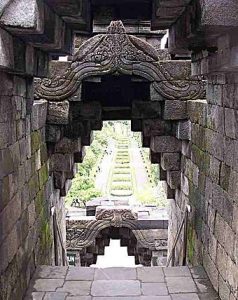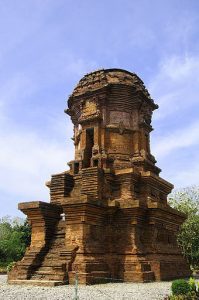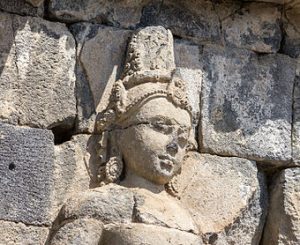Materials
Most of well-preserved candi in Indonesia are made from andesite stone. This is mainly owed to the stone’s durability, compared to bricks, against tropical weathers and torrential rains. Nevertheless, certain periods, especially the Majapahit era, saw the extensive use of red brick as temple and building materials. The materials commonly used in temple construction in Indonesia are:
- Andesite is an extrusive igneous volcanic rock, of intermediate composition, with aphanitic to porphyritic texture. Its colour ranges from light to dark grey. Andesite is especially abundant in the volcanic island of Java, mined from a certain cliffs or stone quarry with andesite deposit formed from compressed ancient magma chamber or cooled down lava spill. Each andesite stone is custom made into blocks with interlocking technique, to construct temple walls, floors and building. Andesite stones are easily formed and carved with iron chisel, making it a suitable material for temple walls and decorations carved as bas-reliefs. The walls of andesite was then carved with exquisite narrative bas-reliefs, which can be observed in many temples, especially in Borobudur and Prambanan. Andesite rocks are also used as the material for carved statues: the images of deities and Buddha.
- Brick is also used to construct temples. The oldest brick temple structure is the Batujaya temple compound in Karawang, West Java, dated from 2nd to 12th century CE. Although brick had been used in the candi of Indonesia’s classical age, it was Majapahit architects of the 14th and 15th centuries who mastered it.[15] Making use of a vine sap and palm sugar mortar, their temples had a strong geometric quality. The example of Majapahit temples are Brahu temple in Trowulan, Pari in Sidoarjo, Jabung in Probolinggo. Temples of Sumatra, such as Bahal temple, Muaro Jambi, and Muara Takus are made from bricks. However, compared to lava andesite stone, clay red bricks are less durable, especially if exposed to hot and humid tropical elements and torrential monsoon rain. As a result, many red brick structures were crumbling down over centuries, and reconstruction efforts require recasting and replacing the damaged structure with new bricks.
- Tuff is a volcanic rock that is quite abundant near Javanese volcanoes or limestone formations. In Indonesian and Javanese languages, tuff is called batu putih (white stone), which corresponds to its light color. The chalky characteristic of this stone, however, has made it unsuitable to be carved into bas-reliefs of building ornaments. Compared to andesite, tuff is considered as an inferior quality building material. In Javanese temples, tuff usually are used as stone fillings — forming the inner structure of the temple — while the outer layer employed andesite that is more suitable to be carved. The tuff quarries can be found in Sewu limestone ranges near Ratu Boko hill. The tuff fillings in the temple can be examined in Ratu Boko crematorium temple. Tuff was used as building material of outer walls of temple compound, such as te walls found buried around Sewu and Sambisari temple.
- Stucco is materials similar to modern concrete, made from the mixture of sand, stone, water, and sometimes ground clamshell. The stucco as temple building material is observable in the Batujaya temple compound in West Java.
- Plaster called vajralepa (Sanskrit: diamond plaster) is used to coat the temple walls. The white-yellowish plaster is made from the mixture of ground limestone, tuff or white earth (kaolin), with plant substances such as gums or resins as binder. The varjalepa white plaster was applied upon the andesite walls, and then painted with bright colors, serving perhaps as a beacon of Buddhist teaching.[16] The traces of worn-off vajralepa plaster can be observed in Borobudur, Sari, Kalasan and Sewu temple walls.
- Wood is believed to be used in some of candi construction or at least as parts of temple building material. Sari and Plaosan temples, for example, are known to have traces of stone indentions to support wooden beams and floors in its second floor, as well as traces of wooden stairs. Ratu Boko compound has building bases and stone umpak column base, which suggests that the wooden capitals once stood there to support wooden roof structure made of organic materials. Traces of holes to install wooden window railings and wooden doors are observable in many of the perwara (complementary smaller) temples. Of course, wooden materials are easily decayed in a humid tropical climate, leaving no traces after centuries.

Interlocking andesite stone blocks forming a corbeling arch in Borobudur.

Red brick Jabung temple, dated from Majapahit period.

Traces of worn off vajralepa plaster on Sari’s relief.
